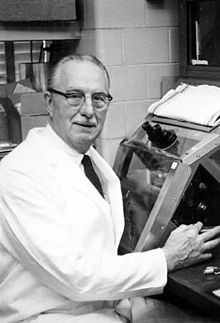George Otto Gey

George Otto Gey /ɡaɪ/ (July 6, 1899 – November 8, 1970) was the scientist who propagated the HeLa cell line.
Biography
Gey was born in Pennsylvania, and both his parents were born in Germany. He received his undergraduate degree at the University of Pittsburgh in 1921 and then taught zoology there.[1] Around 1926 he married Margaret K. (1900–1989), who was from Wisconsin. By 1930 they were living on Saint Paul Street in Baltimore, and in the 1950s they started the Tissue Culture Laboratory at Johns Hopkins University. Using a sample from the cervix of Henrietta Lacks provided by Howard W. Jones, he propagated her cells into an immortalized human cell line.
Gey is also credited for creating the roller drum. This machine was one of the first to help nurture cell cultures. The roller drum consisted of various holes where tissues and their appropriate growth substances were allocated. The drum spun in order to mix the substances and once an hour allow the cultures to be exposed to the environment until the drum rolled again and rebathed the cells in liquid. Gey is also noted to be one of the first to document cell division and growth on film. He devised a time lapse camera that stood twelve feet, built out of spare parts from a nearby junkyard, with a temperature controlled incubator.
He died of pancreatic cancer. When undergoing an emergency procedure for his cancer, doctors found that the cancer had spread to his lymph nodes, lungs and heart, thus making him inoperable. He wanted doctors to try to cut out a piece of the cancer in his liver to grow a new cell line that he wanted to be used for research. The doctors, however, didn't listen to him during the surgery and he was "furious" when he woke up.[2]
References
- ↑ Skloot, Rebecca (March 2001). "An Obsession with Culture". Pitt Magazine (University of Pittsburgh). Retrieved August 27, 2013.
- ↑ The Immortal Life of Henrietta Lacks, by Rebecca Skloot
Further reading
- Rebecca Skloot, 2010 The Immortal Life of Henrietta Lacks, Random House, ISBN 978-1-4000-5217-2
- Fedoroff, S. (1971). George Otto Gey. 1899–1970. Anat Rec 171(1): 127–128.
- Hanks, J. H. and F. B. Bang (1971). Dr. George Otto Gey 1899–1970. In Vitro 6(4): 3–4.
- Harvey, A. M. (1975). Johns Hopkins, the birthplace of tissue culture: the story of Ross G. Harrison
- Warren Y. Lewis, and George O. Gey. Johns Hopkins Med J 136(3): 142–149.
- Jones, H. W., Jr., V. A. McKusick, et al. (1971). George Otto Gey (1899–1970). The HeLa cell and a reappraisal of its origin. Obstet Gynecol 38(6): 945–949.
- Skloot, R.; Obsessed With Culture: George Gey and his quest to cure cancer, with the help of Henrietta Lacks (2001).